18 Restaurant Technology Tools You Need to Power Your Business
Molly Weinberg
5 min read
Jun 20, 2025

Molly Weinberg
5 min read
Jun 20, 2025

Let’s face it, choosing the right technology for your restaurant can feel like navigating a maze. With so many options available, it’s hard to know where to start.
The good news is, there are solutions out there designed to make your life easier, streamline your operations and give your guests the kind of personalized service they expect today.
In this article, we’ll break down the key tech categories every restaurant should consider, and give you a head start by highlighting some of the best vendors in the game.
A restaurant CRM is the centralized hub that powers your entire front-of-house (FOH) tech stack. While CRM features vary, the best hospitality CRMs integrate reservation, online order, marketing, guest feedback and POS data all in one. With a CRM, you can track customer data, such as:
Then, you can use this data to build robust guest profiles that inform your service and marketing efforts, allowing you to personalize experiences at scale to drive deeper guest loyalty.

Top Solutions: SevenRooms, Eat App, Tock
Your POS system is where sales transactions, inventory tracking and sales reports come together. A cloud-based solution that connects to your other systems (like CRM and table management) is key.
Many restaurants now use handheld POS systems, allowing servers to deliver the check and close out the tab in a single visit. This not only speeds up service but also boosts table turnover.
Top Solutions: Toast, TouchBistro, Lightspeed
The best reservation platforms do more than just take bookings. They help collect important guest details, optimize your booking flow and provide opportunities to drive more revenue through prepayments and upsells.
Look for reservation systems that integrate with your CRM and POS systems to help you tailor the guest experience. Additionally, systems that send automated SMS or email reminders can help reduce no-shows and keep your dining room full.

Top Solutions: SevenRooms, OpenTable, Resy
A table management system optimizes your restaurant seating layout according to your floor plan. Front-of-house staff can use it to keep a pulse on seating availability, waitlists and table turnover.
Best-in-class table management systems use AI algorithms to predict guest arrival patterns, optimize seating arrangements and reduce wait times. This enhances your guests’ dining experience and optimizes your floor plan, allowing you to generate more revenue.
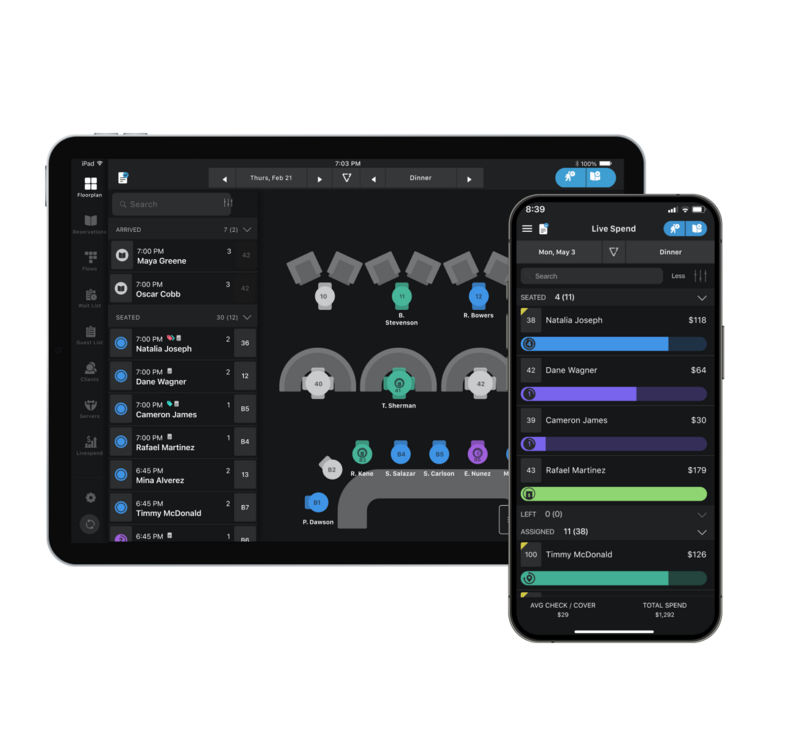
Top Solutions: SevenRooms, CAKE, Eat App
Virtual waitlist solutions allow walk-in guests to join your list by scanning a QR code on-site, going to your website or social media channels or by calling your restaurant.
These systems help your FOH team work more efficiently while better managing guest expectations and improving the overall experience.

Top Solutions: SevenRooms, Waitwhile, NextME
When implementing a virtual waitlist, be sure to collect guest emails and dietary preferences at booking — you can leverage this data to engage with guests later. Send them a post-visit survey or invite them to join your loyalty program to encourage repeat visits.
AI is quickly changing the game for restaurant operators, and diners are ready for it. Our recent data report revealed 79% of diners are comfortable with restaurants using AI in the reservation process, such as booking or modifying reservations via AI emails, texts or phone.
AI-powered voice assistants and website chatbots can help reduce call volume for staff, manage reservations, take orders and address FAQs.
For example, Humble Grape uses an AI chatbot to quickly engage with website visitors and funnel inquiries from customers to the relevant stream — like weddings or private events versus an FAQ.

You can also use AI to draft responses to customer inquiries via email and text — simply craft your responses in your preferred sentiment and tone, edit and send them. On average, SevenRooms customers using AI-powered messaging show a 27% decrease in response time for guest inquiries across email, SMS and reviews.
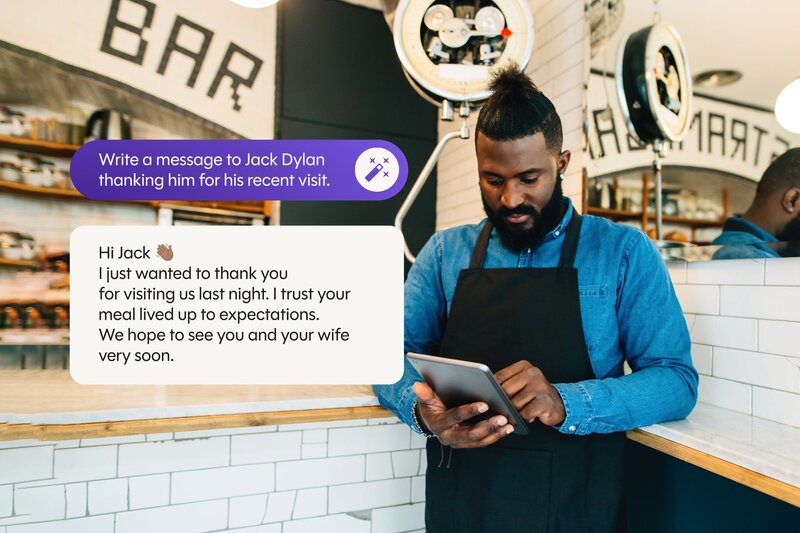
Top solutions: SevenRooms, Streebo, Slang.ai
Unless you’re a cash-only operation, you’ll need a card reader to process card and mobile payments quickly. Look for a card reader that accepts the latest payment technologies – magnetic stripes, chips, contactless cards and mobile payments like Apple Pay or Google Pay.
If your restaurant offers online ordering for delivery and pickup, make sure your payment processor also enables you to take online payments.
Top Solutions: Stripe, Square, TouchBistro Payments
If your restaurant hosts special events and experiences, an online prepayment process is vital for booking. This will streamline operations, but more importantly, help restaurateurs maximize revenue through item add-ons and upsells.
For example, the Pump Room in Bath, England, not only collects prepayments during the booking process but also encourages guests to upgrade their reservations with prepaid food and drink packages for its traditional afternoon tea service.
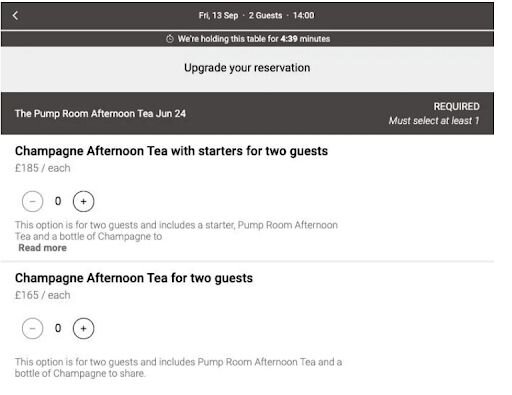
Top Solutions: SevenRooms, Bentobox, Tock
With any online ordering or prepayment strategy, be sure to list your cancellation policy on each reservation and send reminder emails and texts to drive revenue and retention seamlessly.
Online ordering platforms make it easy for your customers to place off-premise delivery and takeout orders (and for your staff to manage them). The best online ordering solutions also come with integrated payment solutions to ensure smooth transactions.
There are two main types of online ordering solutions: direct and third-party.
With direct ordering solutions, you maintain control over your brand and customer data, allowing for more personalized marketing and customer relationships. You’ll also avoid commission fees, saving money in the long run. However, direct solutions may require more setup and ongoing maintenance. They also don’t offer access to large consumer networks which can limit your marketing efforts.
Third-party platforms are quicker to implement and provide access to large customer networks but many systems come with commission fees and limited customer data, which can hinder personalized marketing and long-term loyalty efforts.
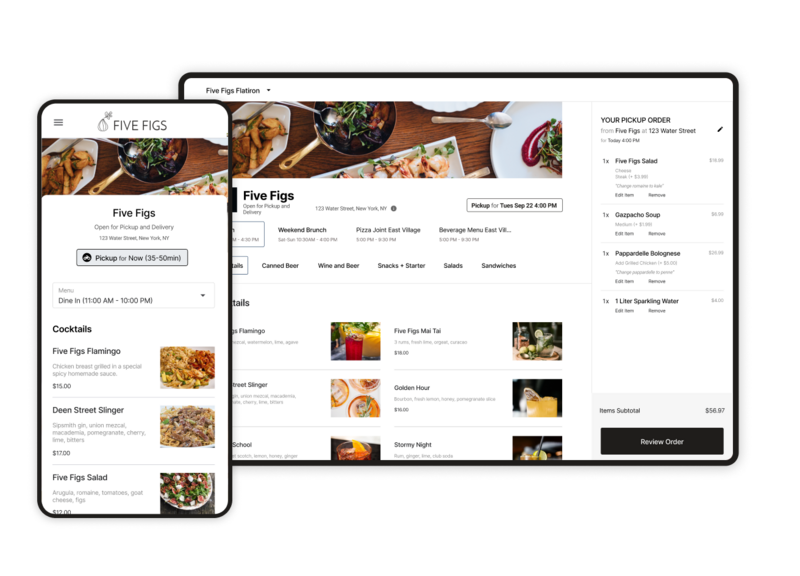
Top Solutions: SevenRooms, DoorDash
A KDS, or kitchen display system, is a digital version of a ticket system for your back-of-house (BOH). When orders are placed via your POS, they appear on a screen in the kitchen. This vital piece of restaurant tech lets you see how long tickets have been open and helps your BOH team manage its time more efficiently.
Top Solutions: TouchBistro, Toast, Lightspeed
This restaurant industry technology tracks inventory to help you order only what you need to avoid food waste and under-ordering. A restaurant inventory management system can also help simplify accounting and purchasing and control food costs by tracking every ingredient purchased and used in your restaurant.
Top Solutions: Restaurant365, MarketMan, Upserve
Accounts payable software digitizes and automates tedious accounting tasks, such as bill payments, invoice management and spend management. When shopping for AP software for restaurants, prioritize solutions with powerful reporting features, real-time analytics and customizable workflows that improve operational efficiency.
Top Solutions: Plate IQ, xtraCHEF, Restaurant365
Restaurant employee scheduling software helps you do much more than build shift schedules. It uses historical data, forecasting and AI to automate scheduling, so you can staff the right amount of employees based on predicted foot traffic.
Some solutions also come with team communication and timekeeping tools, which help balance labor costs and employee wellbeing.
Top Solutions: 7shifts, Restaurant365, ZoomShift
For restaurants, marketing is crucial for retaining customers. In fact, 62% of consumers prefer connecting with restaurants via email.
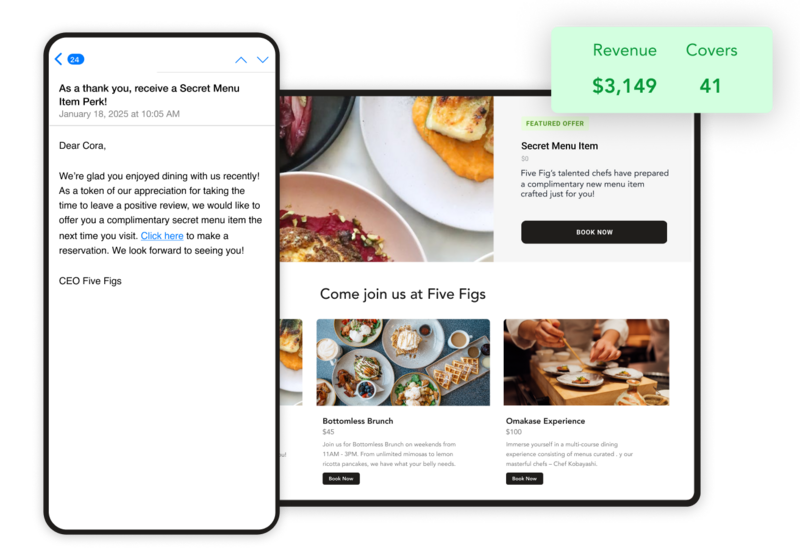
SevenRooms’ data shows that personalized email marketing—delivering the right message to the right guest at the right time—drives higher engagement and revenue. Restaurant email marketing software can automate many of the proven personalization strategies, such as:
Top Solutions: SevenRooms, Eateria, Marketing 360
FoodFund International incentivizes repeat bookings by sending personalized follow-up emails to guests using SevenRooms’ pre-built marketing automation campaigns. In nine months, they generated 2,932 covers and 654,083 AED in incremental revenue from automated emails alone.
SevenRooms found that 48% of consumers prefer to connect with restaurants via text — especially when it comes to time-sensitive messages and reservation updates. Text marketing tools allow you to send texts at scale and drive last-minute revenue.
Some text marketing software, like SevenRooms, lets you quickly customize text templates and send them to specific customer segments.
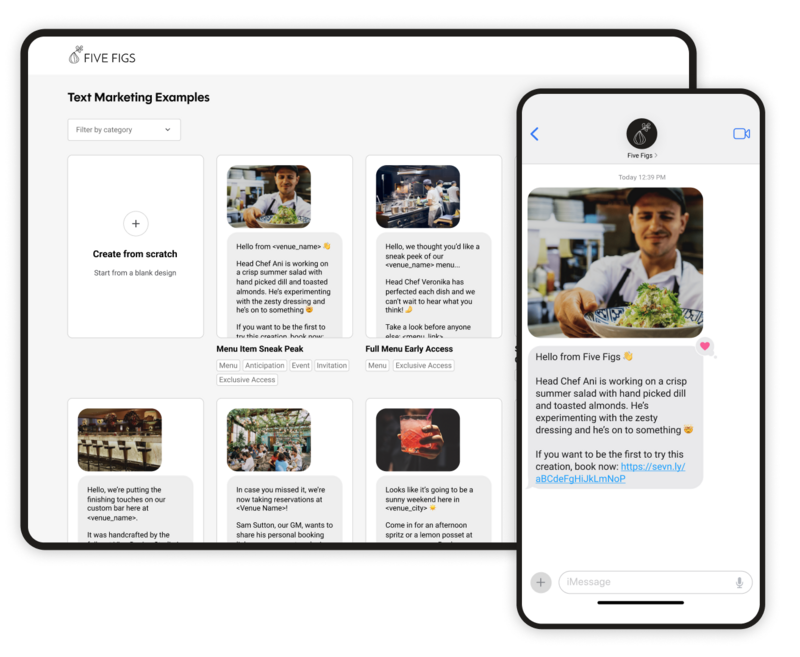
To send compliant text message campaigns, you need to obtain guests' consent through an opt-in process. Promote SMS opt-ins on your reservations widget, in email campaigns and on social media profiles.
Top solutions: SevenRooms, Twilio
Choose a software that allows you to integrate texts into your broader multichannel marketing strategy, so you can use email and text messages together. For instance, you might send an email campaign highlighting new menu items and then follow up with a text a few days later to promote last-minute reservation offers.
With more diners using Google and social media to discover restaurants, it’s crucial to keep a pulse on guest sentiment. Reputation management tools help you monitor your restaurant’s online reputation and respond to reviews quickly. Look for tools that have the following capabilities:
Collect guest feedback by automatically sending customer surveys after every meal. If a customer selects a low rating, you can send an automatic response to buy time before reaching out directly to recover the customer.
Link customer reviews to guest profiles and add auto-tags, such as “positive reviewer,” based on ratings. This way, you can send thank you messages to positive reviewers and create win-back marketing campaigns for diners who had less-than-ideal experiences.
Top solutions: SevenRooms, Sprout Social, Mention
If your restaurant hosts private or ticketed events and experiences, you’ll want to add event booking software to your must-have list of restaurant industry technology.
Event management software lets you sell tickets online, manage bookings and access insights about event sales and attendance.
Look for a system that includes CRM integration, tracking capabilities, customizable landing pages, guest tags and secure online payment options, so guests can easily find your events and prepay for them on your website with just a few clicks.
For example, Terra Solis uses SevenRooms to streamline event management and drive revenue. Hosting events such as themed dinners and pool packages, the venue generated over AED 2.8 million between July and December 2024.
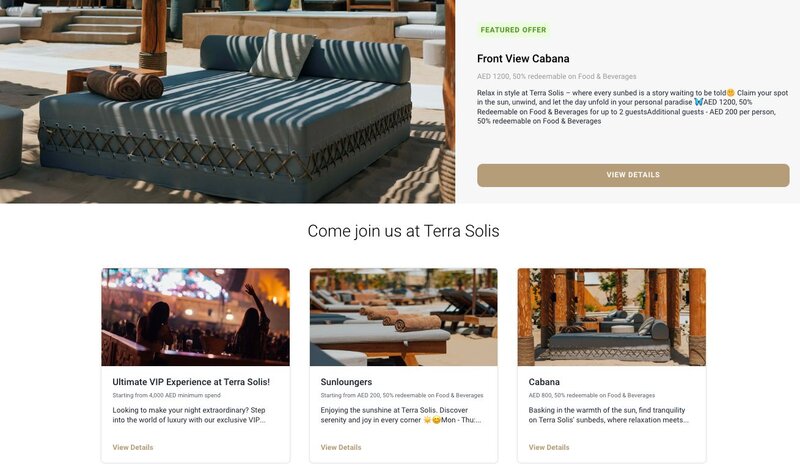
“We used to send out messages on WhatsApp trying to explain our different pool packages and pricing options. Now, we simply copy the link to our experiences landing page. Guests can view everything we have to offer and book right away,” says Sami Neaimeh, director of operations at Terra Solis.
Top Solutions: SevenRooms, Tripleseat, Perfect Venue
KDS systems replace paper tickets with digital screens, improving communication and efficiency in the kitchen. Real-time tracking helps ensure timely order preparation and prevents errors.
This type of self-serve technology is best suited for venues serving quick bites and fast food that don’t require extensive staff or customer interaction.
Top Solutions: Square, Toast, Lightspeed
We understand that it can be overwhelming to choose the right technology tools for your business. The key is finding solutions that either integrate seamlessly with each other or provide an all-in-one solution to help consolidate your tech stack.
SevenRooms is an all-in-one CRM, Marketing & Operations platform that streamlines your operations, uncovers opportunities to drive more revenue and helps you build guest loyalty. Learn how easy it is to integrate SevenRooms’ robust hospitality solutions today.